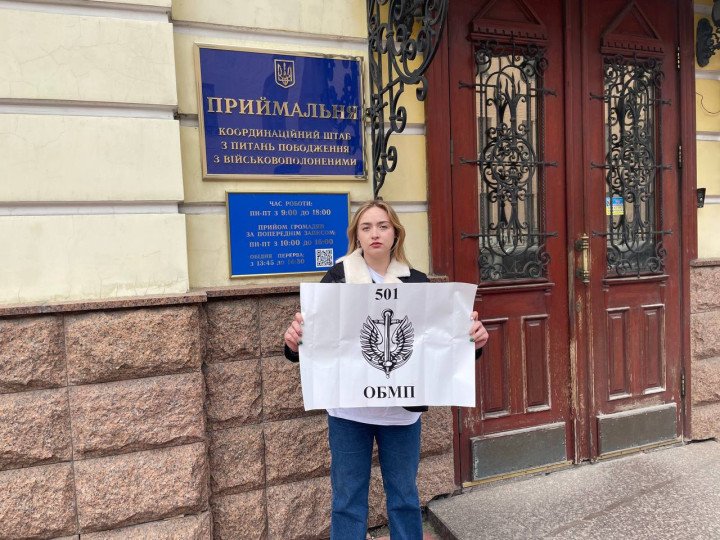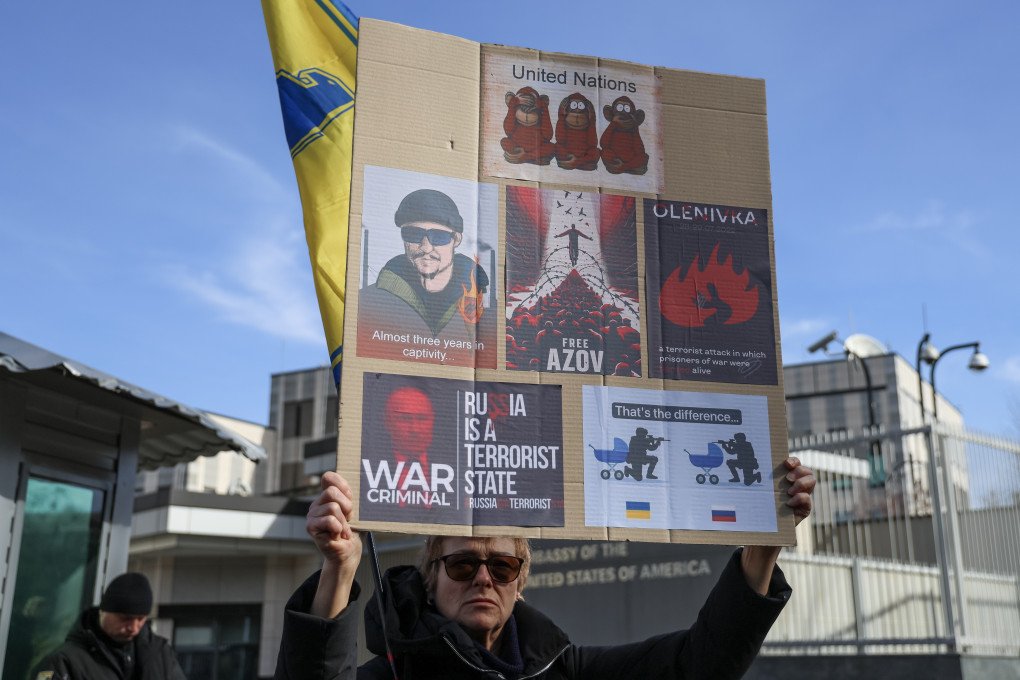- Category
- War in Ukraine
The Ukrainian Wives Who Turned Pain into Power to Bring Their Husbands from Russian Captivity

For nearly three years, Ukrainian wives transformed their pain into action, determined to bring their captive husbands home. Finally, they got them back.
The day before, Alona Skuibida marked her partner’s birthday the same way she had been for the past three years. The next morning, she found herself holding a birthday cake at a prisoner exchange site, waiting for the moment she had fought for since 2022.
Andrii, a marine captured during the defense of Mariupol, was finally coming home. The last time she had seen him in person was before the full-scale invasion. Since then, there had been months of silence, years of uncertainty, and no clear answers. Now, as he stepped off the bus, Alona held out the cake—"27," marking not just his age but nearly three years in captivity.

For families of prisoners, waiting is a process no one prepares you for. When Mariupol fell, thousands of Ukrainian defenders were taken into Russian captivity, including many from the marine brigade. Back then, there was no clear system in place for their relatives—no guidance, no roadmap, no way of knowing if they were even alive.
"I had no idea what to do," Alona recalls. "We were completely in the dark. I only found out Andrii had been captured when a friend sent me a video from a Russian Telegram channel. That was how I saw him for the first time in weeks."
In early April 2022, while fleeing occupied Berdyansk, Alona lost contact with Andrii. Their last messages had been rushed—she told him she was trying to evacuate, and he asked her to let him know when she was safe. By the time she reached Ukrainian-controlled territory and sent a message, he was already gone. Days passed with no word, until she opened the video.
"There was nothing we could do. No one to turn to. Back then, support groups and official guidance didn’t exist like they do now. We had to figure everything out ourselves."
For more than two years, she, along with hundreds of other families, campaigned, pushed for answers, and waited. Now, the wait is over—for her, at least. But many others are still hoping for the same moment.
Captivity
Since Russia’s full-scale invasion, the fate of Ukrainian prisoners of war has become a painful and urgent issue for thousands of families. Each exchange is a moment of relief for some and renewed anguish for others still waiting.
As of March 2025, Ukraine has conducted 62 prisoner swaps, bringing home 4,306 of its citizens. The latest exchange on March 19 secured the release of 197 defenders, according to Ukraine’s Ombudsman, Dmytro Lubinets.

For the Marine Corps, the pain of captivity hasn’t faded. After the grueling 28-day defense of Mariupol in the war’s early weeks, thousands of Ukrainian marines were captured. At least 1,259 remain in Russian prisons today, their fate uncertain, says Alona.
Many families refused to wait in silence. As months passed with little news, they realized they had to fight for their loved ones themselves. Alona was among the first to act.
"At first, we waited. Six months went by, and nothing changed. We had to do something," Alona says. She co-founded an organization for the families of Ukraine’s 501st Marine Battalion, which later expanded into the Association of families of marines, defenders of Mariupol “Marine corps strength”, uniting battalions and brigades under a single cause.
"Each of us was advocating for our own unit, but we realized we had to unite to be stronger and more visible,” she said.
The long wait
Alona first learned of her husband’s capture through Russian propaganda websites. Photos surfaced of prisoners standing in rows, holding numbered signs in front of their chests—visual proof that he was alive. But beyond that, there was silence.
“At first, they were in Olenivka. Then, they were transferred. For a long time, there was no news. Some released prisoners mentioned seeing him, but there was never direct confirmation.”

Over the next two years, she would piece together his whereabouts through secondhand information. Occasionally, a former cellmate would pass on a message, confirming he had been seen. Then, finally, after nearly two years, a letter.
“He told me he had received three of my letters, even though I had written one every three weeks. For almost two years, he was in complete isolation, not knowing if we were still fighting for him.”
Kateryna Haliuk had lived through a similar experience. Her husband Dmytro, also a marine, spent nearly three years in Russian captivity. She knew he had been taken prisoner in Mariupol, but for months, there was no official confirmation.
“They had no food, no water, no ammunition defending the city. It was either death or captivity. In June 2022, the Russian side confirmed he was alive. But for three years, we only received two letters.”
She would not learn any details of his condition until 2024, when a former cellmate contacted her. “That was the first real news we had about him in years.”
Alona and Kateryna know each other well, having met multiple times at rallies in support of prisoners of war.
“We stood outside the Verkhovna Rada in the rain, the snow, the heat—whatever it took,” Kateryna says, describing their experience and that of hundreds of other women and families. They wrote letters, organized peaceful demonstrations, and demanded action. “We did everything possible to bring them home,” she said.

Each prisoner exchange was both a moment of hope and heartbreak. “The hardest part was when exchanges happened, and he wasn’t on the list,” Kateryna admitted. “You have to gather yourself again, piece by piece, and keep going.”
“You break down with every exchange, and then you pull yourself together and fight again,” Alona said. She found solace in small rituals—crafting jewelry, practicing yoga, and seeing a therapist. “At first, I hated monotonous work, but beading helped me focus. I sold my creations and donated the money to the military. It gave me a purpose.”
Kateryna and her 6-year-old daughter, Sofia, wrote letters, enclosing their photos. “So he would know we were waiting, that we hadn’t disappeared,” she said.
The last time Sofia saw her father, she was two and a half. At first, Kateryna told her that he was on an important mission. When she turned four, she explained the truth. “I told her that dad was in enemy captivity, that he had no way to call, no way to reach us. I explained why we go to rallies,” she said.
Sofia stood beside her mother at protests, through rain, snow, and sun. “She never cried, never complained,” Kateryna said. “If she could fight, how could I not?”
The day of the exchange
Women learned to live with the waiting. But nothing could prepare them for what came next.
For Alona, the news of Andrii`s exchange arrived as a shock. “I called my friend—her husband was also in captivity. We work together, so she has seen me go through this a thousand times. I asked her, ‘What do I do now?’ And she just laughed and said, ‘What do you mean? Start packing!’”
Despite knowing exactly what steps to take—how to book a ticket, what clothes to bring—her body froze. “It was as if my brain shut down. I had imagined this moment so many times, but when it finally came, I couldn’t process it.”

For the first 48 hours, it didn’t feel real. “I kept thinking it was a mistake. I`m still processing it—he is actually home.”
Kateryna received the news of Dmytro's return on a regular weekday when she was picking up her daughter from kindergarten.
“I opened a Telegram channel and saw the list. Dmytro was on it. But I didn’t believe it. Too many times, fake lists had been posted just to torment us.”
She quickly called other women in similar situations, and their optimism reassured her. “They told me, ‘Wait, it might be real this time.’” She rushed home, packed their bags, and waited for the phone to ring.
The moment Kateryna saw her husband was through a video call. “They asked me, ‘Are you sure?’ I said yes. And then they turned the camera around, and there he was.”
For Alona, the first call from Andrii was just as overwhelming. “I heard his voice, and I thought—how is this possible? I had forgotten what it was like to hear him speak to me.”
Even when she was on her way to the hospital to see him, the reality hadn’t fully sunk in. “I kept thinking—am I really about to see him? Is he really here? it was hard to comprehend.”
Adapting to freedom
The return from captivity is not an immediate transition to normal life. The initial moments involve basic needs—bathing, eating, changing into fresh clothes, Alona explained.
Afterward, the process of reintegration begins, including the restoration of documents, medical check-ups, and determining necessary treatment. Some need urgent hospitalization, while others undergo further assessments.
All people who get back are placed under quarantine for a week due to health risks, as they were confined in cells with others suffering from infectious diseases. This time also allows them to process their return mentally.
For family members, this waiting period is difficult. After years of anticipation, being told to wait another week feels unbearable. However, many understand the importance of allowing their loved ones to gradually adjust. "This is necessary so that the guys can get back to their senses," says Alyona.
At first, many former prisoners struggle to believe they are truly free. "Their adrenaline is running high, they don’t quite understand what’s happening. As the initial excitement fades, exhaustion, physical pain, and untreated conditions from captivity start surfacing," explains Kateryna.
But the toll is not just physical—many returnees and their families experience emotional numbness. Seeing a loved one again after years of separation does not always bring immediate relief. Instead, a sense of shock often takes hold, making the reunion feel surreal.
Psychologists work closely with both soldiers and their families to help them process these emotions. Before meeting her husband, Kateryna had to speak with a psychologist. At first, she didn’t know how to react to the news of the exchange—she felt completely numb.
“The psychologist reassured me that it was a normal response,” she says. The weight of the past years, combined with the uncertainty of what comes next, makes adjusting a slow and complex process.
Yet, even in moments of reunion, there is a deep awareness of those still in captivity. Alona speaks of this painful reality: “War is not only about missiles or mobilization, the things that affect people more directly. It’s also about captivity and waiting. I started crying when I realized that Andrii is home, but so many others are still not. And that hurt."
"From Mariupol, the Mariupol garrison, there are so many captured marines. It turned out that they are the largest group taken into captivity."
For those who have lived through this experience, the fight does not end with one homecoming. "We will keep going until the last military prisoner is freed," Kateryna said.


-6359eca46c72bde40a90abaaadd6eaa8.png)
-29a1a43aba23f9bb779a1ac8b98d2121.jpeg)


-206008aed5f329e86c52788e3e423f23.jpg)
